L'importance de la polarisation dans les applications laser
Auteurs : Hayden Kim
La lumière peut être considérée comme une onde électromagnétique transversale composée de champs électriques et magnétiques oscillants. L'orientation du champ électrique dans l'onde lumineuse est décrite par la polarisation de la lumière. De nombreuses sources lumineuses, y compris la lumière du soleil, l'éclairage halogène et les projecteurs LED, sont considérées comme non polarisées parce que l'orientation de leurs champs électriques fluctue de manière aléatoire dans le temps. Les sources laser, quant à elles, sont souvent polarisées linéairement.
La compréhension de la polarisation laser est importante pour de nombreuses applications, car la polarisation a un impact sur la réflectance, la focalisation des faisceaux laser et d'autres comportements optiques qui affectent les applications finales du laser. Bien que la plupart des sources laser soient polarisées linéairement, d'autres classifications de polarisation peuvent également être générées, telles que la polarisation circulaire, elliptique et radiale. Les principes de base de la polarisation sont traités dans notre note d'application Introduction à la polarisation, mais ce guide se penche sur l'application spécifique de ces concepts aux applications laser.
Polarisation des sources laser
L'état de la polarisation d'un laser est déterminé par plusieurs mécanismes anisotropes du milieu de gain du laser ou du résonateur. Le terme « anisotrope » fait référence aux propriétés dont les valeurs varient dans différentes directions. Un milieu de gain laser peut dépendre de la polarisation, comme c'est le cas pour certains cristaux laser anisotropes et amplificateurs optiques à semi-conducteurs. Dans ce milieu, l'émission est stimulée par des photons de pompe entrants. Les photons d'émission stimulés seront émis dans le même état de polarisation que celui des photons de la pompe. En l'absence d'optiques de sélection de la polarisation, telles que les polarisateurs et lames à retard (également appelées lames d’ondes ou retardateurs), la lumière ne serait pas polarisée et ne conviendrait pas à certaines applications. En outre, les pertes dans le résonateur, dues à l'inclusion d'une plaque de Brewster ou à un léger désalignement de tout autre composant optique impliqué, peuvent être à l'origine de changements dans les émissions laser polarisées.
Le rapport d'extinction de polarisation $ \left( \text{PER} \right) $ peut être utilisé pour déterminer le degré de polarisation après propagation à travers un dispositif ou un système, tel qu'une cavité laser. Il s'agit du rapport entre la puissance optique dans le mode de polarisation principal et le mode de polarisation orthogonal, où chacun de ces modes est perpendiculaire à l'autre. Ces polarisations sont généralement appelées TE (transverse électrique) et TM (transverse magnétique). $ \text{PER} $ est souvent présentée comme un rapport entre les deux états de polarisation orthogonale (par exemple 100:1, indiquant que la quantité de lumière polarisée dans la direction principale est 100X celle de la lumière dans la direction orthogonale). Par exemple, le $ \text{PER} $ des systèmes laser Systèmes de Laser Haute Performance Coherent® OBIS™ LX/LS est de 100:1, tandis que le $ \text{PER} $ des Lasers Lumentum Helium-Neon Haute Performance à polarisation linéaire est de 500:1. $ \text{PER} $ peut également être exprimée en décibels, ce qui se calcule de la manière suivante :
Dépendance de la réflectance à l’égard de la polarisation
Une onde lumineuse unique est constituée de deux composantes indépendantes et orthogonales constituant les états de polarisation p et s, qui sont essentiels dans les applications utilisant la réflexion et la transmission de certaines polarisations de la lumière. Pour la lumière polarisée p, le champ électrique est parallèle au plan d'incidence d'une interface tandis que le champ électrique est perpendiculaire au plan pour la lumière polarisée s (Figure 1).

Figure 1 : P et s sont des polarisations linéaires définies par leur orientation relative par rapport au plan d’incidence. Cette figure montre également l'angle de Brewster, pour lequel aucune lumière polarisée p n'est réfléchie à une interface optique.1
Il est important de comprendre cela lorsqu’il s’agit de la propagation de la lumière à une interface entre deux milieux avec l'introduction de l'angle de Brewster. L'angle de Brewster est un angle d'incidence auquel la lumière polarisée p est transmise tandis que la lumière polarisée s est partiellement réfléchie sur une surface optique non traitée (Figure 2). Le concept est appliqué dans les cavités laser pour transmettre entièrement la composante polarisée p de la lumière et pour introduire des pertes pour la composante polarisée s par réflexion. L'angle de Brewster peut être déterminé par les indices de réfraction du milieu incident à travers lequel la lumière se propage $ \left( n_1 \right) $ et d'un autre milieu $ \left( n_2 \right) $.
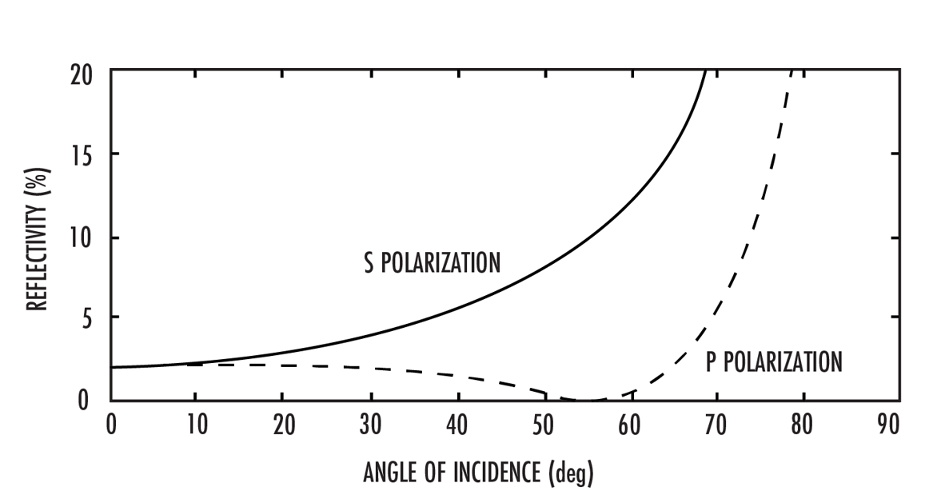
Figure 2 : Réflectivité de Fresnel à une interface optique air-verre en fonction de l'angle d'incidence. Pour la polarisation p, la réflectivité disparaît à l'angle de Brewster (dans ce cas, ~56°) alors que la réflectivité pour la polarisation s augmente régulièrement avec l'augmentation de l'angle d'incidence.8
Il existe de nombreux composants optiques qui utilisent le concept de l'angle de Brewster pour des applications utiles. Une fenêtre de Brewster est un substrat transparent orienté à l'angle de Brewster, utilisé lorsqu'un faisceau de lumière se propage à travers une fenêtre transparente avec des pertes optiques minimales. Prenons l'exemple d'un laser hélium-néon (He-Ne) doté d'un tube en verre scellé et de miroirs externes plan-convexes. Aux extrémités du tube de verre se trouvent des fenêtres transparentes nécessitant moins de 1% de pertes par passage. Lorsque les fenêtres de Brewster sont placées soigneusement de chaque côté du tube, la réflectivité aux interfaces air-verre devient nominale pour la lumière polarisée p, ce qui permet d'éviter les effets d'interférence dus à la réflexion résiduelle à l'intérieur du résonateur (Figure 3). Les différences considérables de perte entre les polarisations p et s induisent une polarisation p de la sortie du laser.

Figure 3 : Le système laser comprend un laser He-Ne avec deux fenêtres de Brewster ayant la même orientation à l'intérieur du résonateur laser. La lumière polarisée p est transmise de manière significative, ce qui induit une orientation globale de la polarisation p de l'émission laser.
La lame de Brewster est similaire à la fenêtre de Brewster. Elle est généralement insérée dans un faisceau laser polarisé de manière à ce que la lumière transmise ressorte polarisée p. Cependant, contrairement à une fenêtre de Brewster, la lame est composée de surfaces coplanaires. La lame introduit un décalage parallèle de la position du faisceau proportionnel à l'épaisseur de la lame (Figure 4). Fréquemment utilisées dans les résonateurs des lasers constitués de cristaux laser de grande surface, les lames de Brewster introduisent des pertes de polarisation pour la composante s et obligent le faisceau laser à atteindre une polarisation linéaire stable.
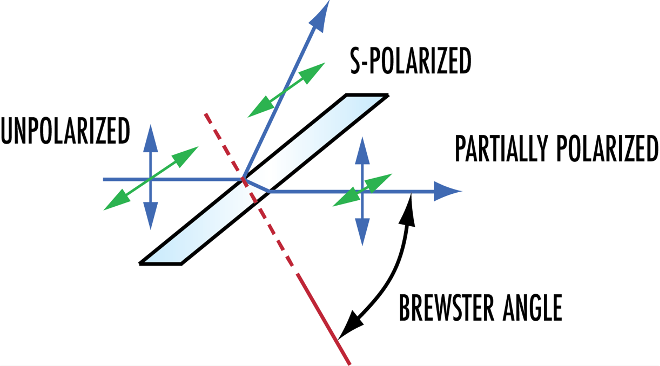
Figure 4 : Lorsqu'un faisceau laser traverse une lame de Brewster avec un angle d'incidence proche de l'angle de Brewster, le faisceau transmis est polarisé en p tandis que le faisceau réfléchi est polarisé en s en raison des pertes par réflexion.
En revanche, les miroirs à déphasage nul reflètent de la même manière la polarisation p et la polarisation s. Cela permet de maintenir la polarisation du faisceau laser incident.
Dépendance de la polarisation de la focalisation laser
La polarisation d'un faisceau laser influe sur la manière dont il est focalisé. Des recherches menées par Qinggele et al. en 2015 ont montré que la focalisation de faisceaux à polarisation circulaire produisait des spots symétriques à la limite de diffraction, tandis que les faisceaux à polarisation linéaire se focalisaient en spots allongés dans la direction de la polarisation.9 Ces effets sont légers et négligeables dans de nombreuses applications, mais des applications précises exigent qu'ils soient pris en compte afin de s'efforcer d'obtenir des spots focalisés limités par la diffraction.
Applications de la polarisation dans les applications laser
La sortie d'un laser polarisé peut être utilisée dans de nombreuses applications utiles dans l'industrie de l'optique laser.
Combinaison de faisceaux de polarisation
Également connue sous le nom de couplage de polarisation, cette technique superpose plusieurs faisceaux laser à polarisation linéaire et peut être divisée en deux sous-catégories : la combinaison de polarisation cohérente et la combinaison de polarisation incohérente.
Dans le cas de la combinaison cohérente de polarisation, les états de polarisation orthogonaux de deux faisceaux cohérents sont superposés, ce qui entraîne une émission laser purement linéaire (Figure 5). Cela n'est possible que si les deux faisceaux injectés sont polarisés linéairement de façon orthogonale avec une différence de phase de $ \delta = n \pi $, où $ n $ est un nombre entier. Grâce à ce rendement, la technique peut être répétée plusieurs fois pour augmenter la puissance globale de l'émission laser, ce qui est également connu sous le nom de mise à l'échelle de la puissance. Cette technique est utilisée dans les systèmes laser à amplificateur de puissance.

Figure 5 : Deux faisceaux laser cohérents sont combinés pour produire un nouveau faisceau de sortie à polarisation linéaire lorsqu'ils se propagent à travers le combineur de faisceaux de polarisation (PBC).5
La combinaison de polarisation incohérente consiste à envoyer des faisceaux de polarisations différentes à travers un combineur de faisceaux de polarisation (PBC) afin d'obtenir un faisceau non polarisé affichant la puissance optique combinée des faisceaux incidents et une luminosité presque doublée. Cette technique implique des faisceaux d'entrée polarisés et une émission non polarisée et n'est donc pas applicable pour une mise à l'échelle de puissance reproductible. Par exemple, un faisceau polarisé verticalement et un faisceau polarisé horizontalement peuvent être envoyés à travers un polariseur à couche mince, de sorte que l'un des faisceaux est réfléchi tandis que l'autre est transmis, les deux faisceaux se propageant dans la même direction.
La combinaison de faisceaux incohérents peut être appliquée au pompage final d'un laser à semi-conducteurs, où la lumière de pompage est injectée dans la direction du faisceau plutôt que dans une direction transversale. Les cristaux laser composés de matériaux tels que le Nd:YAG, qui peuvent absorber le rayonnement de la pompe dans les deux directions de polarisation, peuvent utiliser cette technique. Par exemple, les piles de lasers à diodes, composées de plusieurs barres de diodes disposées en un réseau 2D d'émetteurs pour produire une puissance de sortie de plusieurs kilowatts, souffrent d'une luminosité globale inférieure à celle d'une barre de diodes individuelle. La combinaison de faisceaux à polarisation incohérente peut être appliquée aux piles pour améliorer la luminosité, ce qui permet de pomper des lasers à l'état solide de grande puissance.
Biréfringence
La biréfringence décrit la propriété optique de certains milieux transparents où l'indice de réfraction dépend de la polarisation de la lumière, ce qui entraîne une double réfraction de la lumière dans le matériau. Ce phénomène peut être causé par un certain nombre de facteurs, notamment la structure cristalline du milieu, les champs de contrainte intrinsèques ou induits dans le matériau et l'application de champs électromagnétiques supplémentaires.
Cette propriété est utilisée dans des dispositifs appelés tuners biréfringents, qui réduisent la largeur de bande optique pour la transmission et reflètent la lumière d'autres longueurs d'onde d'un faisceau laser intracavité qui se propage. Le tuner est placé à l'angle de Brewster, puis tourné autour de l'axe perpendiculaire à l'interface de la surface pour induire un retard à la longueur d'onde transmise rétrécie. La longueur d'onde qui nous intéresse ne présente que la composante de polarisation p, ce qui entraîne une perte par réflexion minime, voire nulle. En revanche, les autres longueurs d'onde sont soumises à un retard différent, deviennent polarisées en s et subissent des pertes par réflexion. L'angle d'inclinaison du tuner influence le décalage de la longueur d'onde pour une perte de puissance minimale et est ajusté sur un support équipé d'une vis micrométrique pour des modifications précises.
Un tuner à plaque unique avec un angle d'incidence à l'angle de Brewster est capable de produire des changements de polarisation dépendant de la longueur d'onde par des pertes de transmission pour la composante de polarisation s du faisceau laser. Plus le tuner est épais, plus la gamme spectrale libre est réduite, ce qui définit l'intervalle spectral entre deux maxima de transmission et offre une meilleure résolution spectrale. Le faisceau laser qui se propage subit des propagations légèrement différentes à l'intérieur du filtre de ses rayons ordinaires et extraordinaires, le premier traversant le filtre sans changement tandis que le second est réfracté à un angle. Il en résulte une double réfraction et un chevauchement inégal des contributions au faisceau de sortie. La rotation du tuner autour d'un axe perpendiculaire à la surface déplace les courbes de transmission et modifie inévitablement la direction de la composante extraordinaire de la lumière.
Les tuners biréfringents peuvent également être composés de plusieurs plaques. Le nombre supplémentaire de plaques permet au laser de fonctionner avec le minimum de perte visé. En effet, en augmentant l'épaisseur des plaques, la gamme spectrale libre diminue et les minima de transmission sur la gamme de longueurs d'onde se rapprochent. Pour augmenter encore les pertes par réflexion pour les longueurs d'onde non désirées, des polariseurs peuvent être insérés entre les plaques. Cette configuration, avec certaines épaisseurs de plaques limitées, permet d'obtenir ce que l'on appelle des dépolarisateurs Lyot, qui dépolarisent la lumière polarisée polychromatique incidente.
Doublage de fréquence
Le concept de polarisation non linéaire entre en jeu dans le domaine des lasers à fibre doublés en fréquence. Employé dans certains lasers qui utilisent le Nd:YAG et d'autres cristaux non linéaires comme milieu pour le lasage, le doublage de fréquence produit une onde dont la fréquence optique est deux fois plus élevée que celle de la lumière de la pompe.
Lasers et optiques de polarisation laser chez Edmund Optics®.
Edmund Optics fournit une large gamme d'optiques de polarisation comprenant une variété de polariseurs, de lames à retard, de fenêtres de Brewster et d'isolateurs optiques idéaux pour les applications laser.
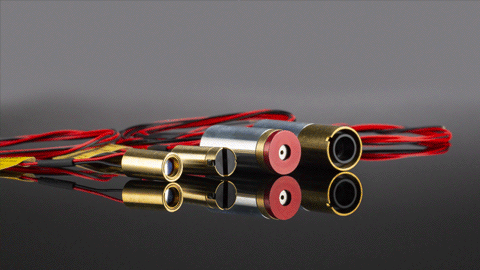
Sources Laser
- Permettent de produire une lumière cohérente qui peut être polarisée ou non polarisée
- De nombreuses applications laser dépendent de l'état de polarisation du faisceau de sortie
- Lasers de vision industrielle, lasers pour les sciences de la vie, lasers de métrologie, lasers à gaz, lasers industriels et de pointage, lasers pour le traitement des matériaux, etc.
ACHETEZ DÈS MAINTENANT
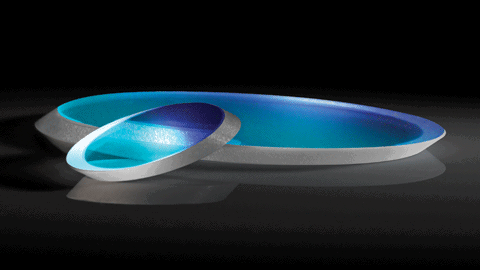
 Fenêtres de Brewster
Fenêtres de Brewster
- Réduisent la perte de lumière polarisée p
- Profil circulaire avec une orientation à 55,57°
- Idéales pour les cavités laser
ACHETEZ DÈS MAINTENANT
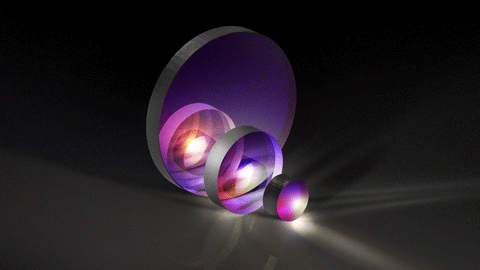
Polariseurs Laser à Couche Mince avec Traitement IBS à Faible Perte
- Longueur d'onde de conception Nd:YAG de1064 nm
- Rapport d'extinction élevé de 10000:1 à l’angle d’incidence de 45°
- Traitement obtenu par pulvérisation ionique (IBS) pour une faible perte
- Substrats de silice fondue UV avec une qualité de surface de 10-5
ACHETEZ DÈS MAINTENANT
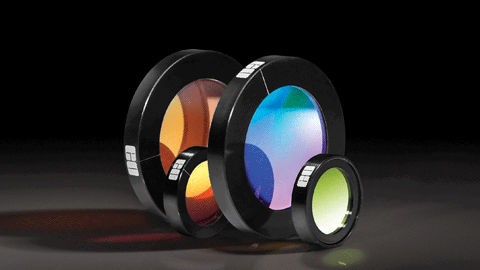
Polariseurs Infrarouges (IR) à Grille
- Conçus pour une gamme de longueur d’onde de 2 à 30 μm
- Différents substrats disponibles
- Rotation de 360° possible grâce aux Montures Polariseurs Métriques
ACHETEZ DÈS MAINTENANT
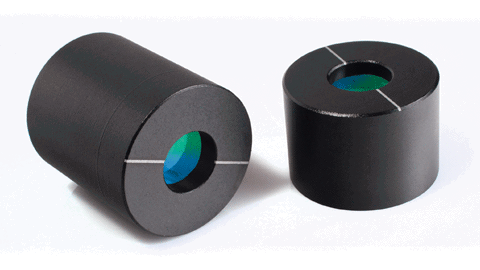
Polariseurs Rochon
- Plusieurs matériaux de polarisation disponibles
- Non déviation des rayons ordinaires
- Déviation des rayons extraordinaires
ACHETEZ DÈS MAINTENANT
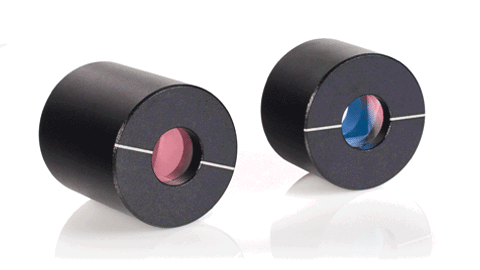
Polariseurs Wollaston
- Plusieurs matériaux de polarisation disponibles
- Gammes de l’UV à l’infrarouge proposées
- Large déviation des rayons ordinaires et extraordinaires
ACHETEZ DÈS MAINTENANT
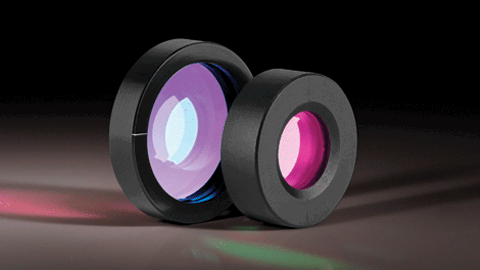
Lames d’Onde Achromatiques (Retardateurs)
- Plusieurs gammes de long. d'onde disponibles
- Réponse uniforme sur chaque large gamme spectrale
- Retard de λ/4 et de λ/2
- Montées dans un boîtier en aluminium anodisé noir
ACHETEZ DÈS MAINTENANT

Lames à Retard de Précision d’Ordre Zéro
- Retard de λ/4 et de λ/2
- Champ de vision angulaire excellent
- Polymère biréfringent
- Seuil de dommage élevé de 500 W/cm2
ACHETEZ DÈS MAINTENANT

Lames à Retard en Quartz (Retardateurs)
- Lames à retard d’ordre zéro et d’ordre multiple
- Retard de λ/4 et de λ/2
- Montées dans un cadre en aluminium noir anodisé
- Lames à Retard en Polymère d’Ordre Zero également disponibles
ACHETEZ DÈS MAINTENANT
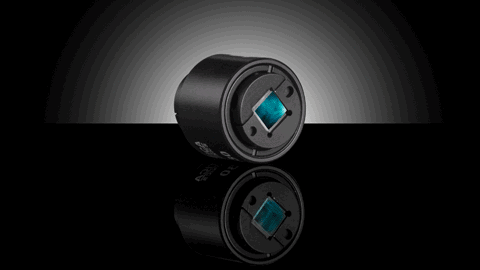
Isolateurs Optiques en Espace Libre
- Isolation jusqu'à 67 dB pour une stabilité optimale
- Jusqu'à 92% de transmission pour une puissance max.
- Ouverture d'entrée de 4,7 mm
ACHETEZ DÈS MAINTENANT
Vous ne savez toujours pas quels sont les produits dont vous avez besoin pour votre application ? Contactez-nous et un expert répondra à vos questions.
Références
- Paschotta, Rüdiger. Encyclopedia of Laser Physics and Technology, RP Photonics, October 2017, www.rp-photonics.com/encyclopedia.html.
- Paschotta, Rüdiger: Field Guide to Lasers. SPIE Press, 2008.
- Collet, Edward : Field Guide to Polarization. SPIE Press, 2005.
- R. Uberna, A. Bratcher and B. G. Tiemann, "Coherent Polarization Beam Combination," in IEEE Journal of Quantum Electronics, vol. 46, no. 8, pp. 1191-1196, Aug. 2010, doi: 10.1109/JQE.2010.2044976.
- Pengfei Ma, Pu Zhou, Yanxing Ma, Rongtao Su, Zejin Liu, “Coherent polarization beam combining of four fiber amplifiers in 100ns pulsed-regime,” in Optics & Laser Technology, vol. 47, pp. 336-340, 2013, ISSN 0030-3992, https://doi.org/10.1016/j.optlastec.2012.08.030.
- Cieślak, Rafał & Clarkson, W.A.. (2011). “Internal resonantly enhanced frequency doubling of continuous-wave fiber lasers.” Optics letters. 36. 1896-8. 10.1364/OL.36.001896.
- A.G. Sedukhin, A.G. Poleshchuk, “Efficient tight focusing of laser beams optimally matched to their thin-film linear-to-radial polarization conversion: Method, implementation, and field near focus”, Optics Communications, Volume 407, pp. 217-226, 2018, ISSN 0030-4018, https://doi.org/10.1016/j.optcom.2017.09.042.
- S. Joseph, V. Michael, “Blue sun reflected from water: optical lessons from observations of nature” 2017, 250. 10,1117/12,2270481.
- Li, Qinggele, Ledoux-Rak, Isabelle, & Diep Lai, Ngoc, "Influence of incident beam polarization on intensity and polarization distributions of tight focusing spot", Advanced Device Materials, Volume1, pp. 4 – 10, 2015, DOI: 10.1179/2055031614Y.0000000002
Ressources supplémentaires
- Introduction à la polarisation
- Guide de sélection des polariseurs
- La microscopie confocale
- Differential Interference Contrast Microscopy
- Comprendre les lames à retard
- Paramètres clés d’un système laser
- Types de lasers communs
- Comment construire un isolateur optique avec des composants de stock
- Introduction à la série vidéo de labo optique laser




























ou consulter les numéros d’autres pays
facile à utiliser
entrer les numéros de stock pour commencer
Copyright 2023 | Edmund Optics, Ltd Unit 1, Opus Avenue, Nether Poppleton, York, YO26 6BL, UK
POLITIQUE DE CONFIDENTIALITÉ | POLITIQUE DE COOKIES | CONDITIONS GÉNÈRALES | CONDITIONS GÉNÈRALES B2C | MENTIONS LÉGALES | ACCESSIBILITÉ
L'entreprise Edmund Optics GmbH en Allemagne agit comme un mandataire d'Edmund Optics Ltd au Royaume-Uni. Le titulaire du contrat est Edmund Optics Ltd au Royaume-Uni.